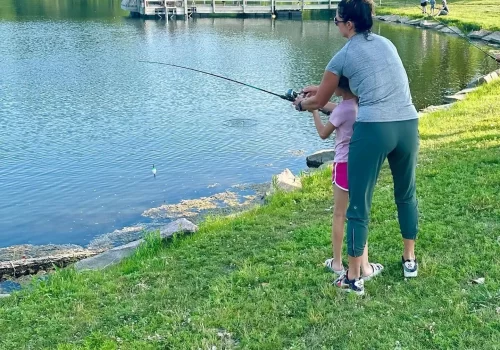Learning how to ride a bike is one of the biggest developmental milestones that propels a child from little to BIG kid status. It’s a momentous occasion where the child gains freedom in the ability to cruise the neighborhood with the older kids, ride to a neighbor’s house, or hit the trails with family. It’s a leisure-based occupation that allows a child to feel part of a group and develop independence as well as responsibility (Mandich, et al., 2003). Just like any developmental milestone, there is a range of what is “normal” as well as the process to how the child may inevitably reach that milestone. However, there are many sensory components to consider when it comes to bike riding!
When learning how to ride a bike, it’s not just being able to sit on the bike and go. There are many other factors that a child must be able to do like able to tolerate wearing a helmet, to feeling confident enough to even try, and many posture and motor planning related components. Strength, balance, coordination, and endurance are measurable motor-based factors that impact the actual physical ability to ride a bike (Schoen & Ferrari, 2022). These factors rely upon accurate information from a child’s muscles and joints (proprioception) as well detection in changes in head position (vestibular) which influence the ability to make accurate postural adjustments, fluidly coordinate the two sides of the body, and project sequential actions such as at what time, how fast, and how big would one turn the handle bars to avoid the upcoming pothole or debris on the sidewalk. Vision, of course, also influences comfort with bike riding. Stabilization of the visual gaze as the body is in motion, accurate shifting of vision to look side to side prior to crossing the road or down from the handlebars or front tire to up at a midline position looking in the distance, and generalized coordination of the two eyes also contribute.
When a child is progressing differently with motor skill acquisition and not responding similarly to peers or siblings when generalized bike riding tactics and techniques are provided, a skilled assessment will be able to help understand individualized differences and the overall what and why of it all. Aside from that, here are some sensory-based recommendations that you can try with your child:
- Preparation – Playful activities that provide the body with more pressure and muscle work such as jump and crash games, climbing, play wrestling, tug of war can be useful for turning on the body awareness system while building confidence. Additionally, swings that a child sits on in a straddled position as if riding a bike or a horse such as a glider or tire swing will ready the movement system. You can add in some fun “reach to get” activities such as batting at a balloon, popping bubbles, or reaching to obtain a toy requiring the child to reach out to the lateral side body and returning back to upright. Doing this prior to attempting to get on a bike or ride on toy will be beneficial for building confidence with posture control, the feet lifting up and off the ground, and engaging vision while maintaining an upright body position.
- Use “You Can” language – Shifting your verbiage from “Do you want to ride the bike” to “You can ride the bike” places a positive and empowering spin on the idea of riding a bike.
- Ride-On Selection – In the developmental scheme of things, a child will progress from a ride-on toy which allows the two feet to move symmetrically at the same time to move the toy to using a reciprocal or walking-like pattern of the feet as the child sits. For a child that becomes very fearful while sitting on an unstable or taller surface, you may select a shorter trike type bike where the body is supported more but is placed relatively close to the ground. These types generally have pedals, so while the posture system is more supported, the child can safely learn the reciprocal motion or movement of the pedals while reducing the amount of attention required on maintaining an upright posture. Balance bikes are incredible as well assuming that a child is not fearful of it due to postural insecurities. These bikes allow the progression from symmetrical to reciprocal patterning of the feet and lower extremities as well as the ability to progress in gliding distance or length of time that feet come off the ground as the bike continues to move. Balance bikes come in a wide variety of sizes as well as the option to add on pedals as the child becomes successful. Regular bikes with training wheels are also an option, but progression from the training wheels to no training wheels can cause heightened stress for a child with heightened sensitivity and fear within the activity. In comparison between a balance bike and a regular child-sized bike with training wheels, a balance bike offers the option of adding pedals to the bike. The regular bike requires removal of the training wheels which psychologically seems much scarier and anxiety provoking.
- Provide specific positive reinforcement and authentic sincerity – Stating “Good Job” can be confusing to a child. Being more specific such as “I love how you sat on the bike” best reinforces the behaviors of the child. For a child with heightened sensitivity, postural control, or motor planning challenges, it might actually be quite hard for them to even get to the point of sitting on the bike or lifting their feet to attempt to balance. Rewarding and celebrating even the smallest of actions can go a long way in building the confidence of the child.
- Social and Fun – The social component of bike riding can be very intrinsically motivating for a child; however, be cautious with helping a child learn how to ride with others around. If your child is very self-conscious and is hesitant to try if others are watching, consider trying without a crowd initially and gradually build up to this.
Bike riding is complex. Depending on a child’s individual differences, variation in strategy and modifications as discussed within this post may be warranted. Building confidence, having fun, and supporting challenge areas through engaging activities that enhance vision, posture, coordination, balance, and endurance are of upmost importance when it comes to helping a child who is struggling to acquire independent 2-wheeled bike riding. If your child is struggling to learn how to ride a bike or is avoidant of considering it as an option, contact Move U. We can help.
Sources:
Mandich AD, Polatajko HJ, Rodger S. Rites of passage: understanding participation of children with developmental coordination disorder. Hum Mov Sci. 2003 Nov;22(4-5):583-95. doi: 10.1016/j.humov.2003.09.011. PMID: 14624835.
Schoen SA, Ferrari V, Valdez A. It’s Not Just about Bicycle Riding: Sensory-Motor, Social and Emotional Benefits for Children with and without Developmental Disabilities. Children (Basel). 2022 Aug 13;9(8):1224. doi: 10.3390/children9081224. PMID: 36010114; PMCID: PMC9406935.



